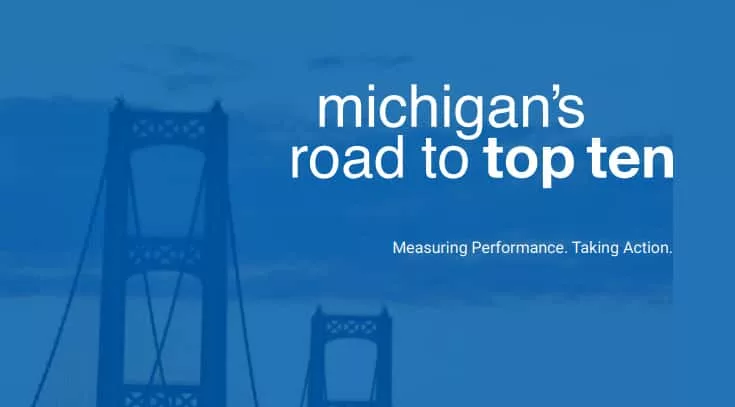The latest Michigan report card boils down to this: “We’re better, but still not the best.” That’s the overly-generalized statement of the man at the helm of the state’s business roundtable known widely as Business Leaders for Michigan. Doug Rothwell, President & CEO of Business Leaders for Michigan presided over a day-long series of discussions Monday with executive leadership from Michigan’s largest businesses and universities as they sat down with policymakers, economic developers and education community for the latest assessment of the state’s progress.
The day was set aside to review data on Michigan’s progress over the past 10 years, while Business Leaders for Michigan also presented specific actions they have identified which elected officials can take to accelerate the state’s standing in those areas where our state is lagging significantly behind other states.
Rothwell says, “We have a great picture of where Michigan stands today on the national scale: better, but still not best.” He adds, “BLM started collecting and analyzing this data 10 years ago, so we have a solid benchmark to see where we’ve grown and how much better off we are than in 2010, and yet, we’ve also identified where huge gaps remain.” Those gaps include:
- Investing in our infrastructure
- Boosting K-12 educational performance
- Growing a working-age population
Rothwell continues, “It’s tough to review some of this data and come to certain realizations: for one, that we’ve been discussing for years how best to improve education and have really failed to move our kids forward.” He adds, “If we do not take concrete actions at the state level to accelerate our work, we will fall further behind other states putting our citizens at a disadvantage to achieving higher incomes and a better quality of life.” He concludes, “Our Board feels an urgency to act on this data and is heavily engaged in conveying these concerns to top policymakers in Lansing.”
Rothwell outlined the top six priorities BLM identified for 2020:
- Strengthen Michigan’s talent base by developing a strategy to attract more immigrants and out-of-state talent…
- Build strong communities by raising sufficient and sustainable revenue to improve our roads and bridges…
- Leverage our key strengths by promoting key industries that have untapped potential to elevate Michigan’s status as a diverse economic powerhouse…
- Design recommendations to improve alignment between community college outcomes and workforce needs…
- Invest in people by advocating for adoption of Launch Michigan’s recommendations and directing more existing funding directly to the classroom…
- Compete for good jobs by establishing the best business attraction program in the country…
Monday’s event also featured leadership from three states that rank in the “Top Ten” – states identified by BLM that perform the highest in the nation on key indicators of jobs, personal income and an overall healthy economy. Ron Starner, a site selection consultant for global corporations, offered insight on advantages other states offer that Michigan does not, touching on infrastructure, talent availability and overall business climate. Gerry Anderson of DTE, who is serving as BLM’s Board Chair for 2020-21, discussed where the organization will focus its efforts in the next two years.
Business Leaders for Michigan released a new website designed to serve as a resource for policymakers in Lansing as well as decision-makers and stakeholders across the entire state. You can see it by clicking the link below. It features independent data from different sources on varying indicators of the economy and quality of life, collected all in one place and signifies whether Michigan is moving forward, falling backward or is stagnant. Here’s the direct link:
http://www.MichigansRoadtoTopTen.com
Business Leaders for Michigan, the state’s business roundtable, is dedicated to making Michigan a Top Ten state for jobs, personal income and a healthy economy. The organization is composed exclusively of the executive leaders of Michigan’s largest companies and universities. The organization’s members drive nearly 40-percent of the state’s economy, generate over $1 trillion in annual revenue and educate nearly half of all Michigan public university students. You can also follow them on Facebook, Twitter and LinkedIn.






